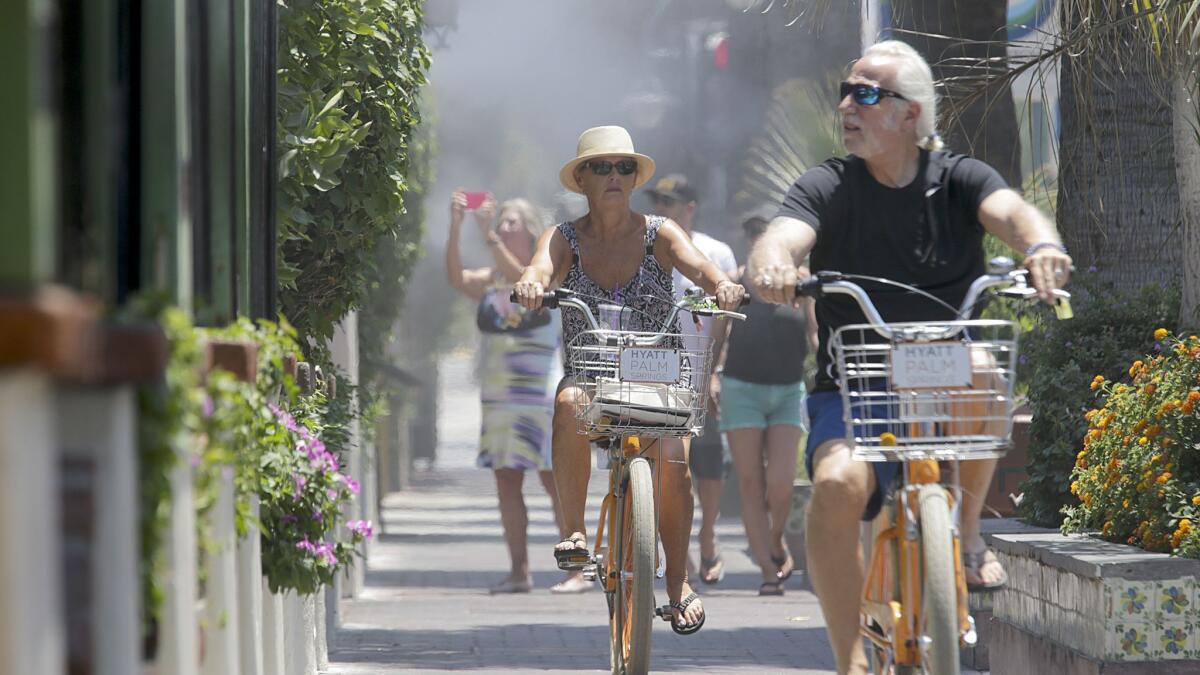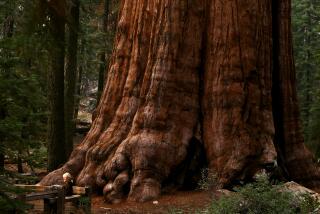Coachella Valley smog has gotten worse, and climate change could be to blame

Air quality officials will miss a 2019 federal deadline to clean smog in the Coachella Valley, saying the challenges of “hotter summer weather and the threat of climate change” are hampering efforts to slash health-damaging ozone.
The South Coast Air Quality Management District said Friday that because of an increase in smog over the last two years it would seek to downgrade the area’s ozone pollution rating from “severe” to “extreme” — the worst federal classification. The change, if approved by the U.S. Environmental Protection Agency, would give the agency five more years to cut Coachella Valley ozone levels below 80 parts per billion.
Though it’s hardly the first pollution-reduction deadline Southern California has busted, the request is notable in highlighting how climate change might be a new front in the war against smog.
Ozone, the lung-searing gas in smog that triggers asthma and other respiratory illnesses, has surged in Southern California in recent years, bucking a decades-long trend of improvement. Air quality officials blame persistent, record-breaking heat and stagnant weather — rather than an increase in emissions — for boosting levels across California and other Western states.
Regulators and scientists say global warming will make smog harder to control because higher temperatures speed up the photochemical process by which pollution from factories, power plants, vehicles and other sources form ozone.
“We do know that the changing climate plays a role in air quality,” South Coast air district spokeswoman Nahal Mogharabi said in an email. “Hotter temperatures and stagnant weather experienced throughout California have directly led to increases in high levels of ozone and fine particulate matter during certain parts of the year.”
The South Coast air district’s governing board last fall authorized a $250,000 meteorological study into the causes of recent bad air spells and whether climate change is a contributing factor. Staff members hope to begin work this summer.
Smog in the Coachella Valley and other inland communities is generated largely by pollution that blows in from cities to the west and builds to unhealthy levels on hot, sunny afternoons.
Ozone levels in the Coachella Valley increased in 2017 and 2018, according to the South Coast air district. Last year was also the hottest year on record in Palm Springs, according to an analysis of federal temperature data by the scientific research and communications organization Climate Central.
Riverside County Supervisor V. Manuel Perez, who sits on the South Coast air district governing board, blamed the worsening air quality on “our location downwind of the air basin, hotter temperatures and fires.”
“The increase in ozone levels over the last two years is not the fault of the Coachella Valley, or the South Coast AQMD,” Perez said in an email. The district, he added, “is doing everything it can by granting dollars for clean energy, clean vehicles, and paving of dirt roads.”
The air district said the new classification required to secure a later 2024 deadline could force it to do more and impose stricter rules and permitting requirements on polluting facilities.
With more time, “we are confident that projected emission reductions coupled with our strict regulations will allow us to combat ozone levels and meet federal standards under this new deadline,” South Coast air district executive officer Wayne Nastri said in a statement.
Cleaning Southern California’s air to federal health standards will require sweeping emissions cuts and billions in spending to switch to lower-polluting vehicles and equipment over the next several years. The South Coast Air Basin, a region of 17 million people across Los Angeles, Orange, Riverside and San Bernardino counties, has long suffered the nation’s worst ozone pollution.
In 2018, the region violated federal health standards for ozone pollution on 141 days, according to state Air Resources Board data. It also logged 145 bad air days in 2017, up from 132 days in 2016 and 113 the year before.
Last year, people in the region also had to cope with unusually persistent smog, including an 87-day stretch of bad air days, the longest in at least 20 years.
More to Read
Start your day right
Sign up for Essential California for news, features and recommendations from the L.A. Times and beyond in your inbox six days a week.
You may occasionally receive promotional content from the Los Angeles Times.







